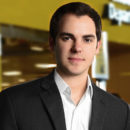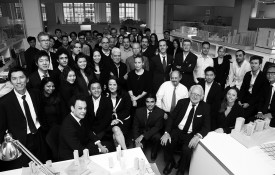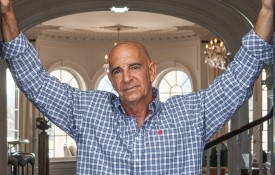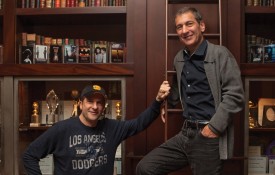It’s one thing to recognize the importance of emerging markets, but quite another to develop a platform with financial news, up-to-the-minute reporting and insightful analysis served to an entire hemisphere.
As an entrepreneur and digital media strategist, Kaio Philipe is applying his experience gained as a senior executive with major tech companies such as KAYAK and Google, as well as finance institutions such as CitiBank, to develop a media company in partnership with Bloomberg and The Falic Group that reaches over 25 million people. The result is Bloomberg Línea, a digital media platform covering financial markets and business news in more than 20 countries across the Americas.
Bloomberg Línea was launched in August 2021, during the apex of the pandemic. Today, the media platform publishes original content in Portuguese, Spanish and English, together with localized content from Bloomberg News.
Although Philipe has achieved this, as well as a host of industry accolades before the age of 40, he remains humble, never forgetting his origins as an immigrant and the positive impact created by serving quality content to previously underserved audiences. He chatted with us about the evolution of digital media, the challenges of delivering content to broad audiences geographically, and his perspective as a father in forecasting the cultural change underway with future generations.

Bloomberg Linea officially launched in August 2021
WHAT WOULD YOU LIKE READERS TO UNDERSTAND ABOUT WHAT BLOOMBERG LÍNEA IS
AND HOW IT WORKS?
Bloomberg Línea is a partnership between Bloomberg Media and Falic Media. It is a new brand as well as platform for news content in Spanish and Portuguese about economic and business developments throughout Latin America that is growing on the strength of great journalists we’ve carefully selected. We are also proud of the fact that our original content has been replicated in publications like the Wall Street Journal’s, TechCrunch. The Financial Times. We’re not just delivering news to our subscribers but providing valuable references for journalists, who can be very picky about the reference they use.
ALTHOUGH BLOOMBERG LÍNEA HAS BEEN AROUND FOR LESS THAN TWO YEARS,
WHY HAS IT MADE SUCH A GREAT IMPACT?
We’ve been very successful in the digital front, because our goal was originally to become a top industry player. While we are already leading the path, we ultimately want to become number one as a news source and multimedia platform covering key events in Latin America, so a greater number of readers can stay up to date with what’s happening in different countries across the region.
WALK US THROUGH THE JOURNEY OF BLOOMBERG LÍNEA, AND EXPLAIN HOW THE NEEDS
YOU WERE ADDRESSING HELPED SHAPE THE ENDEAVOR.
We realized there was an opportunity to create an essential product serving Latin America in both Spanish and Portuguese. We recognized it was a major opportunity–we’re talking about 600 million people—and globally, we’re talking about many up and coming economies and businesses. Furthermore, average people are consuming more (information channels) and getting more digitally savvy. As mobile phones are more affordable than computers, they rely on that for their connections to the world. For people relying on news in the Spanish and Portuguese markets, a product like this had great potential to provide a one-stop shop for the finance and business information to succeed.
Why create a “one-stop shop”? Before Bloomberg Línea, nothing existed that could connect the dots between a main website and social media, podcasts, web series, newsletters, and events to and from nations throughout Latin America. With our platform, one can read news about Panama, and then easily access similarly relevant news videos from Brazil, Venezuela, Argentina, and Mexico and 10 more countries. To get a complete picture before Bloomberg Línea, a reader would have to go to numerous local websites and rely on local outlets. And many of those sources are general news, and not so much into finance, business economics.
GIVEN LATIN AMERICA’S DIVERSE POPULATION, WHAT DOES BLOOMBERG LÍNEA’S
BUSINESS MODEL ACCOMPLISH THAT OTHER PLATFORMS CANNOT?
If you asked the average person in Colombia or Mexico about Chile, they may not know much about its economy other than lifestyle elements such as the wine and the mountains. However, if there’s a place where one can go to read news about all of these countries in a seamless way, in their native language, they have a greater likelihood of becoming better-informed about people and places in their vicinity. A business like this also makes sense because there is an emerging middle class in Latin America and its Spanish speaking communities. They have savings accounts and money invested in the bank. Each region has its own culture and heritage, as well as economic history. Even if one of our subscribers moves to the U.S. or Europe, and grew up with an awareness of what was happening in Latin America, they will still need access to their news sources to keep track of how changes around the globe will affect Latin American business.

Philipe during the filming of an interview with Bloomberg Linea at the Nasdaq
WHAT ROLE DOES EVERYDAY TECHNOLOGY PLAY IN THE WAY BLOOMBERG LÍNEA
CONNECTS MILLIONS OF USERS FROM SO MANY DIFFERENT PLACES?
Thanks to mobile phone and internet usage becoming more widespread, more people everywhere can have access to the knowledge they need to invest in stocks on the NASDAQ, the Dow Jones, or the New York Stock Exchange as well as any other international markets. Before our endeavor, it was harder for our users to get the information they needed to compete. There is also the venture capital industry, with many unicorns coming from Spanish and Portuguese founders. There’s significant interest in emerging industries and companies coming out of Latin American countries. All these factors create a perfect storm of need, so why not create something to address the needs of that market, which is growing exponentially?
TELL US ABOUT THE ORIGIN STORY OF BECOMING A CO-FOUNDER OF BLOOMBERG LÍNEA
I think I am sort of a “launch and interact” person and my motivation is to create businesses for people like me…always thinking about what’s next. I had an understanding of the Spanish-speaking world and could bring to the table, and was confident that together in some form of partnership we could make interesting things happen. Bloomberg Línea grew out of this, from the concept, to the name, to where and how we would take it to the marketplace. From there, one could say I took the leap and went for it. Entrepreneurship is about execution.
WHAT WAS IT LIKE TO BUILD THIS BUSINESS FROM THE GROUND UP DURING COVID?
The timing looked right, Bloomberg Línea first conversations started in 2020 and I fully joined to co-found and as the COO in March 2021. Five months later, we launched the website and went live in eight countries. Rather than overthink whether we should launch one year or the next, my attitude was, “Let’s just do it. Let’s find the right providers. Let’s hire the right people. And let’s make sure that we don’t lose money.”
Although I was remote like most people during that time, I had to bring people onboard. In spite of the fact that I couldn’t meet candidates in person, my first priority was the editorial team in Argentina, Brazil, Colombia, Mexico, Chile, Peru, and Panama. Next, I reflected upon whether we should embrace the remote work business model from day one. While it would work as we were estimating there would be a manageable number of people involved full time (approximately 100), we still had to figure out how to ensure those we hired were working and productive. After that, we had to figure out what the culture of our company would be like. To help it take shape, first we brought the most senior editorial folks who would set the standards and manage content. I also had to figure out what markets would launch next, and where the biggest opportunities were. It was important to determine how and from where we would source simple stuff like computers and then send the right equipment to the right person to be able to operate, and so on. In short, it was and still is quite challenging to operate in a continent with such diverse countries and cultures like Latin America, but ultimately rewarding.
WHAT CONSIDERATIONS DID YOU MAKE DURING THE HIRING PROCESS AND VETTING
OF REPORTERS AND OTHER EMPLOYEES IN DIFFERENT LATIN AMERICAN COUNTRIES?
Figuring out who and where to hire was a process, and it differed between Mexico and Brazil, for instance. How do you convince a person to join a project that hasn’t launched yet when you are just a face in a Zoom meeting – and this person is used to working in a (face-to-face relationship) for as many as 25 to 40 years for established organizations in their countries? Although I didn’t come from a news media background, I recognized that I needed to have the right people in place to help me build–especially when setting up a global brand with credibility.
There were high expectations on everybody’s shoulders, the Bloomberg brand has been around for decades. While who we hired could make or break the project, I believe we attracted the right people because of the energy we put out and their believing in what we were building. I think they noticed we were creating something that disrupted the status quo in a positive way, in terms of building a specific product for specific regions that needed to be better served. People followed that, and that’s why we attracted top talent, because we’re creating something needed, even though the industry is the same, right?

Bloomberg Linea being recognized at the Nasdaq in Times Square
HOW DO YOU SEE YOURSELF PLAYING A ROLE IN THE ECONOMIC GROWTH OF THESE
COUNTRIES?
I am proud of the fact that the company is a bridge that created and will continue to create access, awareness, and opportunity for its users both within and beyond Spanish speaking countries. Its success is a mission I take personally because I have a daughter who was born a U.S. citizen but will always be regarded technically as a Latina, according to the U.S. census. For these reasons, and more, I really believe in the future success of Latin America as a whole. While the population is multicultural, the common thread is we’re really hard workers and we put a great amount of passion into everything we do. If Bloomberg Línea can help the greater community and raise the awareness of thriving Latinos to draw interest from readers from anywhere, then we are doing our jobs.
WHERE DO YOU SEE BLOOMBERG LINEA HEADED IN THE NEXT 12 TO 24 MONTHS?
To answer this question, I want to emphasize the need in today’s world for Millennials like me to roll up our sleeves and constantly anticipate what’s next. We are at our peak, and I see myself contributing to that narrative to develop new trends. More importantly, our generation’s focus is on internationalizing brands, breaking the status quo, and developing ideas that travel will ensure brands like Bloomberg Línea can launch anywhere. Even if we’re now in a down economy, new technologies and opportunities will be arising. It is up to us to make it happen. More importantly, we are collectively driving more awareness to and within Latin America, that contributes to more people and companies in the region to have better chances to succeed. Even for audiences who might not speak fluent English, they are becoming more informed through quality content. The more we can contribute for smart, ambitious audiences to thrive, the better it will be for our entire ecosystem.
As a product, and business, 18 months after our launch in August 2021, we are becoming the leading media for Business and Finance in the Spanish and Portuguese worlds, and we couldn’t be prouder.














































